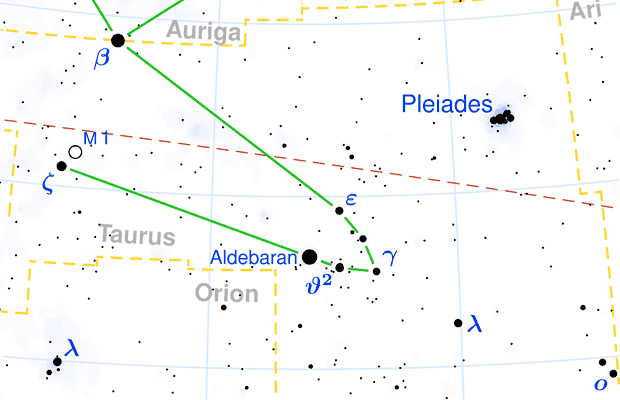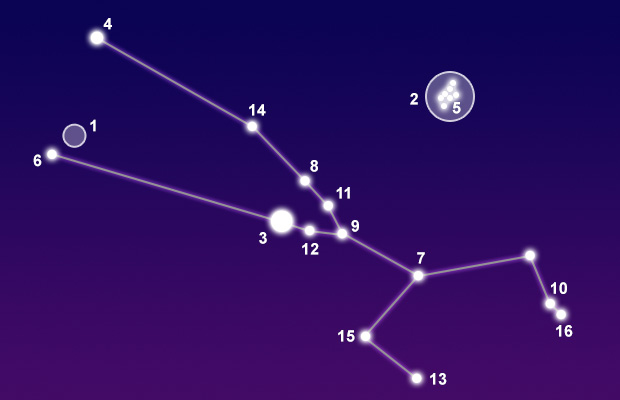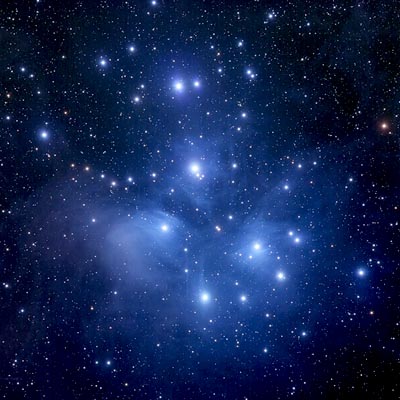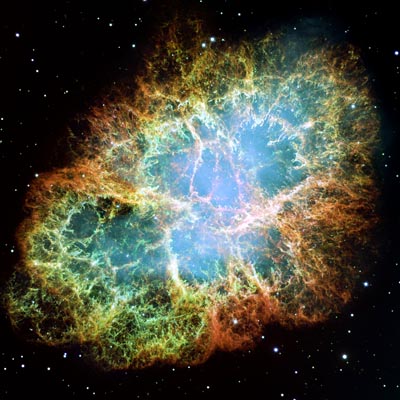Pronunciation:
(TOR-us)Abbreviation:
TauGenitive:
TauriRight Ascension:
4 hoursDeclination:
15 degreesArea in Square Degrees:
797Crosses Meridian:
9 PM, January 15Visible Between Latitudes:
90 and -65 degreesThe constellation Taurus, the bull, can be seen during the winter and the early spring in the northern hemisphere. It is visible at latitudes between 90 degrees and -65 degrees. It is a large constellation covering an area of 797 square degrees. It ranks 17th in size among the 88 constellations in the night sky. It is bordered by Aries to the west, Gemini to the east, Perseus and Auriga to the north, Orion to the southeast, Eridanus to the south, and Cetus to the southwest. It is one of the thirteen constellations of the zodiac. This means it lies along the path the Sun travels in the sky during the year. Taurus is one of the more recognizable constellations in the sky. The V-shape of the horns in very easy to find and can be seen even in urban areas with light pollution.
Taurus is one of the 48 constellations cataloged by the Greek astronomer Ptolemy in the second century. Its name means “bull” in Latin. It is an ancient constellation dating back to the Bronze Age, where it marked the location of the Sun during the spring equinox. Its importance to agriculture influenced the mythology of many ancient civilizations including Sumer, Assyria, Babylon, Egypt, Greece, and Rome. Depictions of the constellation have been found in cave paintings dating back to 15,000 BC. In Greek mythology it is believed to represent the story of Europa and the bull. The story tells of Europa, daughter of Agenor, who was King of Phoenica. One day Europa saw a majestic white bull grazing near her father's herd. The bull was actually Zeus in disguise. After allowing Europa to climb on its back, the bull whisked her off to Crete where he made her his mistress.


M45
Aldebaran
Elnath
Alcyone
Zeta Tauri
Lambda Tauri
Ain
Hyadum I
Xi Tauri
Hyadum II
Theta Tauri
Nu Tauri
Tau Tauri
Mu Tauri
Omicron Tauri
Pleiades
"Follower of the Pleiades"
"The Butting Horn"
Daughter of Atlas
N/A
N/A
"Second Eye of the Bull"
"First Hyad"
N/A
"Second Hyad"
N/A
N/A
N/A
N/A
N/A
Open Star Cluster
Orange Giant Star
Blue-White Giant Star
Binary Star System
Binary Star System
Triple Star System
Orange Giant Star
Yellow Giant Star
Triple Star System
Orange Giant Star
Binary Star System
White Dwarf Star
Triple Star System
Blue-White Subgiant Star
Yellow Giant Star
1.60
0.86
1.68
2.87
3.01
3.47
3.53
3.65
3.73
3.77
3.84
3.91
4.26
4.27
4.86
Taurus is famous for the bright stars Aldebaran, Elnath, and Alcyone. Aldebaran is the brightest star in the constellation with a visual magnitude of 0.86. it is also the thirteenth brightest star in the sky. It is an orange giant star located about 65 light years from Earth. The second brightest star in Taurus is Elnath with a magnitude of 1.68. It is a blue-white giant star that lies approximately 131 light years away. Alcyone is the third brightest star with a magnitude of 2.87. Alcyone is the third brightest star in Taurus and the brightest member of the Pleiades star cluster. It is a binary star system whose primary member is a blue-white giant star. The system is located some 370 light years from our solar system.
Taurus is the home of two very famous Messier objects. Perhaps the most famous of these is M45, the Pleiades. Known also as the Seven Sisters, the Pleiades is an open cluster of about 500 stars, six of which are visible to the naked eye. All of these stars formed from the same cloud of gas about 100 million years ago. The seven brightest stars are named after the seven daughters of Atlas, the titan who holds up the sky. At a distance of only 390 light years, it is one of the closest open clusters to our solar system. The other Messier object in Taurus is also quite famous. The Crab Nebula, also known as M1, is a supernova remnant that formed about a thousand years ago in the year 1054. It was formed when an old star blew itself apart in a catastrophic supernova explosion. Another notable object in Taurus is the Hyades. It is another open cluster of about 200 stars. This cluster can be found nestled within the horns of the bull. Taurus contains a number of other deep-sky objects that are too dim to be seen with anything other than a large telescope. These include a variable nebula known as Hind’s Variable Nebula, a pair of colliding galaxies known as NGC 1410 and NGC 1409, a planetary nebula known as the Crystal Ball Nebula, and a diffuse reflection nebula called the Merope Nebula.

© Boris.stromar / CC BY-SA

the Hubble Space Telescope



